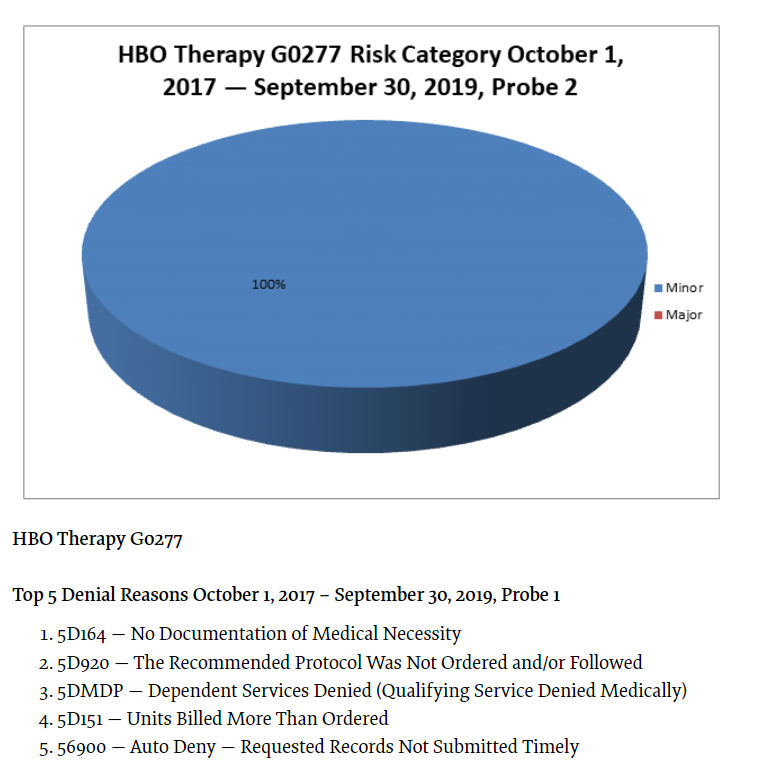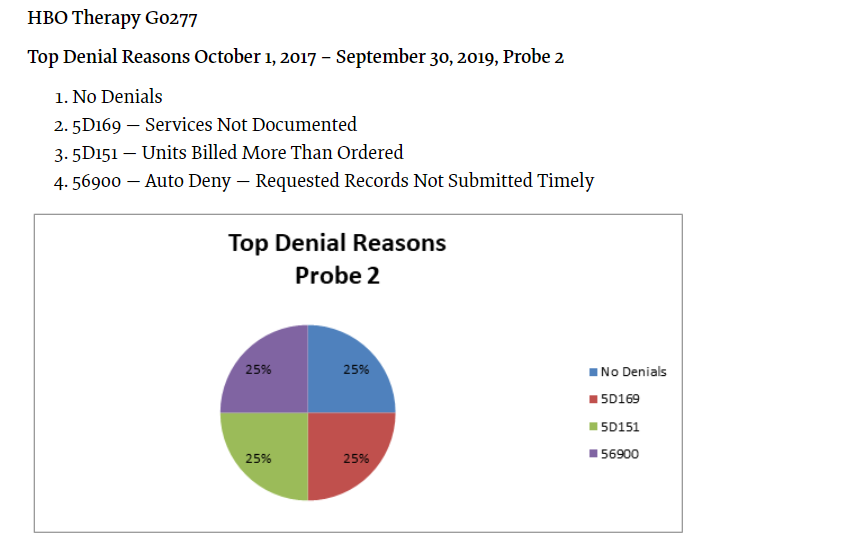This is part of my series of articles about Useful Information on Medicare Audits.
Palmetto is the MAC for:
- Region J: Alabama, Georgia, Tennessee (Region J)
- Region M: North Carolina, South Carolina, Virginia, West Virginia (excludes Part B for the counties of Arlington and Fairfax in Virginia and the city of Alexandria in Virginia)
- Home Health and Hospice for: Alabama, Arkansas, Florida, Georgia, Illinois, Indiana, Kentucky, Louisiana, Mississippi, New Mexico, North Carolina, Ohio, Oklahoma, South Carolina, Tennessee, and Texas
Targeted Probe and Educate Progress Update: HBO Therapy G0277
The website does not describe what a major or a minor “risk category” IS. Apparently, all of the reasons for denial are “minor”? Does that make it better? If you know, contact me. Note that each reason for denial has a code (e.g., 5D164 – which stands for “no documentation of medical necessity”).
I will point out a few highlights below such as: the need to document associated chemotherapy is applicable (?), clinical signs and symptoms, any prior treatments, and a clear physician’s order with indication of need, dose, frequency and route (many MACs require that the order for HBOT include the number of SEGMENTS to be used per treatment in the order for HBOT…)



5D164/5H164 — No Documentation of Medical Necessity
Reason for Denial
This claim was fully or partially denied because the documentation submitted for review does not support the medical necessity of some of the services billed.
How to Avoid a Denial
- Submit all documentation related to the services billed which support the medical necessity of the services
- A legible signature is required on all documentation necessary to support orders and medical necessity
- Use the most appropriate ICD-10-CM codes to identify the beneficiary’s medical diagnosis
5D920/5H920 — The Recommended Protocol Was Not Ordered and/or Followed
Reason for Denial
Medicare cannot pay for this service because one or more requirements for coverage were not met.
How to Avoid a Denial
Documentation that may be helpful to avoid future denials for this reason may include, but are not limited to, the following:
- Clear physician’s order with indication of need, dose, frequency and route
- Date and time of associated chemotherapy, as applicable
- Relevant history and physical and/or progress notes
- Clear indication of the diagnosis
- Clinical signs and symptoms
- Prior treatment and response as applicable
- Stage of treatment as applicable
- Documentation of administration
5DMDP/5HMDP — Dependent Services Denied (Qualifying Service Denied Medically)
Reason for Denial
The dependent services will not be covered if the qualifying surgery has been denied. For example, the surgical procedure was denied as documentation did not support medical necessity, therefore all other charges cannot be allowed and will be denied as dependent to the medical denial of the qualifying service.
How to Avoid a Denial
Documentation that may be helpful to avoid future denials for this reason may include, but is not limited to, the following:
- All documentation to support orders, documentation of services rendered and documentation of medical necessity for the qualifying services for the date(s) billed
5D151/5H151 — Units Billed More Than Ordered
Reason for Denial
The physician’s orders submitted did not cover all of the units billed.
How to Avoid a Denial
In order to avoid unnecessary denials for this reason, the provider should ensure that the physician’s orders cover all the services to be billed prior to billing Medicare. When responding to an Additional Documentation Request (ADR), ensure that all orders for services billed are included with the medical records.
56900 — Auto Deny — Requested Records Not Submitted Timely
Reason for Denial
The services billed were not covered because the claim was not submitted or not submitted timely in response to an Additional Documentation Request (ADR). When an ADR is generated, the provider has 45 days from the date the ADR was generated to respond with medical records. In accordance with CMS instructions, if the documentation needed to make a medical review determination is not received within 45 days from the date of the documentation request, Palmetto GBA will make a medical review determination based on the available medical documentation. If the claim is denied, payment will be denied or an overpayment will be collected.
How to Avoid a Denial
- Be aware of the ADR date and the need to submit medical records within 45 days of the ADR date
- Submit the medical records as soon as the ADR is received
- Monitor the status of your claims in Direct Data Entry (DDE) and begin gathering the medical records as soon as the claim goes to the location of SB6001
- Return the medical records to the address on the ADR. Be sure to include the appropriate mail code or station number. This ensures that your responses are promptly routed to the Medical Review Department.
- Gather all of the information needed for the claim and submit it all at one time
- Attach a copy of the ADR request to each individual claim
- If responding to multiple ADRs, separate each response and attach a copy of the ADR to each individual set of medical records. Make sure each set of medical records is bound securely with one staple in the upper left corner or a rubber band to ensure that no documentation is detached or lost. Do not use paper clips.
- Do not mail packages C.O.D.; we cannot accept them
5D169/5H169 — Services Not Documented
Reason for Denial
This claim was partially or fully denied because the provider billed for services/items not documented in the medical record submitted.
How to Avoid a Denial
- Submit all documentation related to the services billed
- Ensure that results submitted are for the date of service billed, the correct beneficiary and the specific service billed
Education
Providers are offered an individualized education session where each claim denial will be discussed and any questions will be answered. Palmetto GBA offers a variety of methods for provider education such as webinar sessions, web-based presentations, or teleconferences. Other education methods may also be available.
Next Steps
Providers found to be non-compliant (major risk category/denial rate of 21–100 percent) at the completion of TPE Probe 1 will advance to Probe 2, and Providers found to be non-compliant (major risk category/denial rate of 21–100 percent) at the completion of TPE Probe 2 will advance to Probe 3 of TPE at least 45 days from completion of the 1:1 post probe education call date. Palmetto GBA offers education at any time for providers. Providers do not have to be identified for TPE to request education.
References

Dr. Fife is a world renowned wound care physician dedicated to improving patient outcomes through quality driven care. Please visit my blog at CarolineFifeMD.com and my Youtube channel at https://www.youtube.com/c/carolinefifemd/videos
The opinions, comments, and content expressed or implied in my statements are solely my own and do not necessarily reflect the position or views of Intellicure or any of the boards on which I serve.



